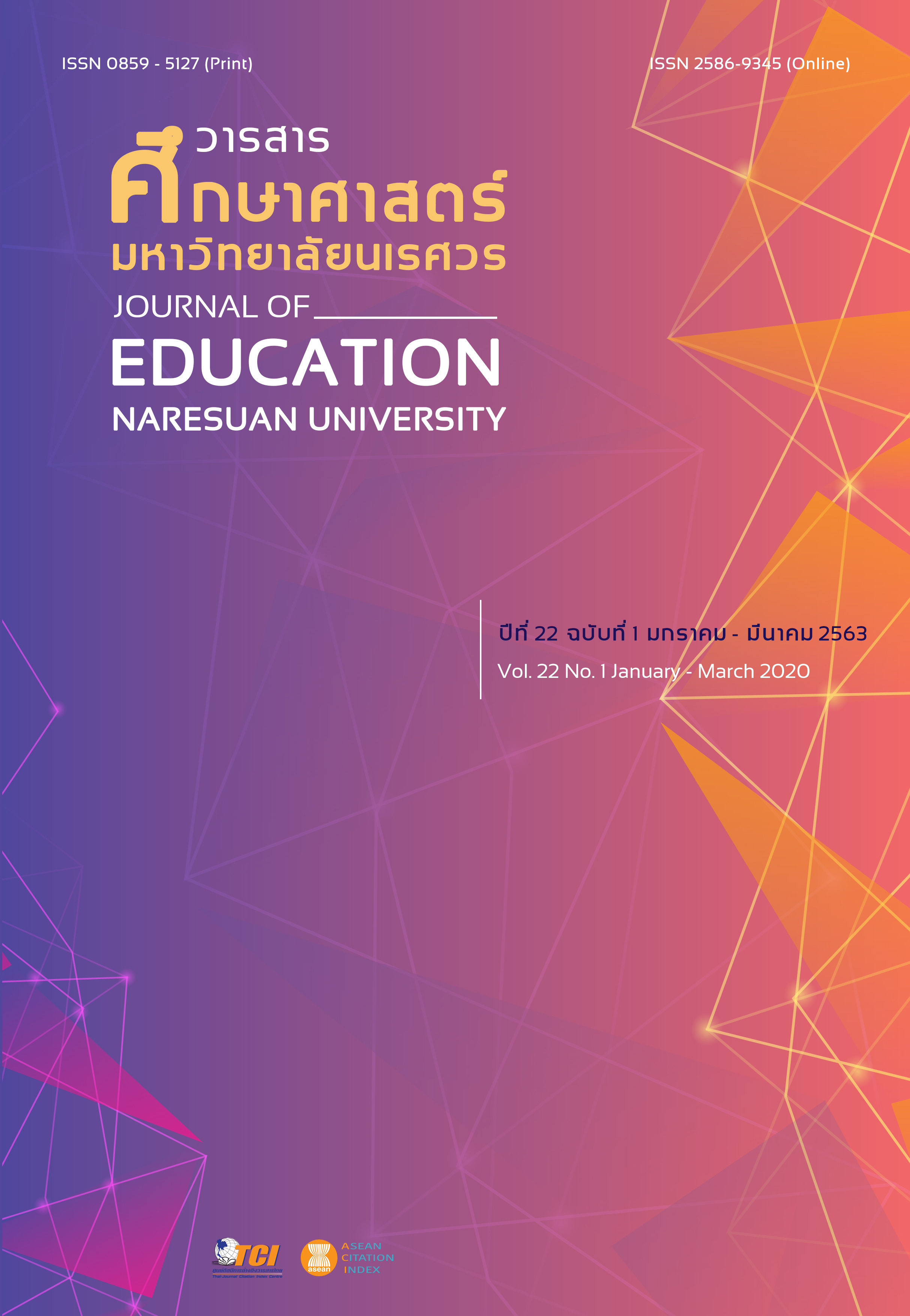WAYS OF USING CREATIVITY-BASED LEARNING MANAGEMENT TO ENHANCE 10th GRADE STUDENTS’ CREATIVE COLLABORATIVE PROBLEM SOLVING ON CHEMICAL REACTION
Main Article Content
Abstract
The purposes of this research were 1) to examine the effective ways of using creativity-based learning to enhance student’s creative collaborative problem solving and 2) to investigate 10th grade students’ creative collaborative problem solving competency through using creativity-based learning approach. The participants of the study were 49 10th grade students registered in 2016 academic year. In the research process, the cycle of PAOR was run in three loops according to classroom action research framework. The research was conduct using the three developed lesson plans. The data were collected by using the creative collaborative problem solving test, reflection journals and the work sheets. Data were analyzed by using content analysis technique and some basic statistics such as mean and percentage were also used. The result showed that the effective ways of using creativity-based learning approach are that teachers should employ creativity-based learning by using easy experiment having a clear and easy –to-get results, less time-consuming and related to the concepts which draw students' attention. Moreover, teacher must employ real-life problems, stimulate students to discuss the problem statement and lead them to reach their consensus at every part of the learning processes and allow students to discover and present the ideas of the experiment and results of the experiment to the class to the class to enhance their understand that they have many strategies available to them and that no single strategy will work for all problems and develop their own solutions. Finally, the student makes conclusion with teacher. In addition, the results revealed that using creativity-based learning approach can help students develop their creative collaborative problem solving and this competency has been improved significantly throughout all the three cycle from cycle I, cycle II and cycle III, respectively.
Article Details
The owner of the article does not copy or violate any of its copyright. If any copyright infringement occurs or prosecution, in any case, the Editorial Board is not involved in all the rights to the owner of the article to be performed.
References
Cholsin, J., Kijkuakul, S., & Chaiyasith, W. C. (2018). The action research for developing learning management on stoichiometry based on stem approach emphasized engineering design process to promote collaborative problem solving competency. Journal of Education Naresuan University, 20(2), 125-141. [in Thai]
Chomphupart, S. (2011). A development of instructional behavior for the creative problem solving of teachers and students at the science gifted students promotion school using emancipatory action research (Doctoral dissertation). Bangkok: Srinakharinwirot University. [in Thai]
Girdtham, C. (1999). Student-centered science teaching. Bangkok: Complex print Press. [in Thai]
Jitjak, F. (2015). Effects of Problem-Based Learning Packages on Chemical Reaction on Achievement and Creative Problem Solving of Grade 12 Student. In The 6th National and International Conference on Research and International Studies (pp. 356-366). Bangkok: Suan Sunandha Rajabhat University. [in Thai]
Khammani, T. (2014). Science of teaching: Body of knowledge for effective management of learning process (18th ed.). Bangkok: Darnsutha Press. [in Thai]
Luachaiphanit, W. (2015). Creativity-Based Learning (CBL). Journal of Learning Innovations Walailak University, 1(2), 23-37. [in Thai]
Organization for Economic Co-operation and Development (OECD). (2013). PISA 2015 draft collaborative problem solving framework. Retrieved August 18, 2016, from https://www.oecd.org/pisa/pisaproducts/Draft%20PISA%202015%20Collaborative%20Problem%20Solving%20Framework%20.pdf
Pornrungroj, C. (2003). Creative thinking. Bangkok: Darnsutha Press. [in Thai]
Poophasuk, W. (2012). Computer multimedia with problem-based learning in science subject to enhance problem solving ability of matthayomsuksa 2 students. Rachaphruek Journal, 10(2), 75-82. [in Thai]
Riangnarong, M., & Silanoi, L. (2015). The development of grade 7 students’ 21st century learning and achievement through creativity - based learning (CBL) in the S 21103 Social Studies Subject. Journal of Education, 38(4), 141-148. [in Thai]
Sornsuwan, N. (2015). Knowledge of 21st century classroom. Retrieved August 18, 2017, from https://lri.co.th/news_detail.php?news_id=312 [in Thai]
Wachirasakmongkol, B. (2012). Group dynamics: Fundamental of collaboration. Rachaphruek Journal, 10(2), 6-17. [in Thai]


